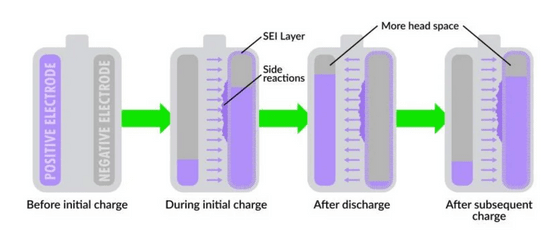Research shows that adjusting the initial charging method of lithium-ion batteries can improve their lifespan by 50%

A research team from
Data-driven analysis of battery formation reveals the role of electrode utilization in extending cycle life: Joule
https://www.cell.com/joule/abstract/S2542-4351(24)00353-2
Researchers discover a surprising way to jump-start battery performance
https://www6.slac.stanford.edu/news/2024-08-29-researchers-discover-surprising-way-jump-start-battery-performance

Lithium-ion batteries have a characteristic that their performance and lifespan are affected by the method of initial charging after manufacture. The research team constructed a pouch-type cell with a positive and negative electrode added to an electrolyte solution, and observed how the battery changed when it was first charged under various conditions. Using machine learning, they identified that the 'temperature' and 'current' during charging had a large impact from the many variables.
Although the positive electrode of a new battery is filled with lithium, repeated charging and discharging will deactivate some of the lithium, reducing the battery's capacity. During the first charge, the deactivated lithium forms a coating called 'SEI' on the surface of the negative electrode, which protects the negative electrode, so it is very important to properly form the SEI.
Previous research has shown that a slow initial charge at a low current can reduce the lithium deactivation rate to 9%, and manufacturers use this method to charge batteries for about 10 hours when they first charge the battery. In this study, the research team discovered that a fast charge at a high current can increase the lithium deactivation rate to about 30%, but the degradation can be suppressed even after charge and discharge cycles. In addition, it is said that this initial charge increases the cycle life by 50% and reduces the time it takes for manufacturers to first charge to 20 minutes.
The team likened a battery to a bucket of water, saying: 'Initially deactivating the lithium ions to free up headspace is like ensuring the rim of the bucket is high, which reduces the amount of water that splashes around during transportation, thus improving the efficiency of charge/discharge cycles in lithium-ion batteries.'

'Rather than brute-forcing the best approach, understanding how things work is essential to finding the optimal balance between battery performance and manufacturing efficiency,' the team said.
◆ Forum is currently open
A forum related to this article has been set up on the official GIGAZINE Discord server . Anyone can post freely, so please feel free to comment! If you do not have a Discord account, please refer to the account creation procedure article to create an account!
• Discord | 'What do you do to make your smartphone or PC battery last longer?' | GIGAZINE
https://discord.com/channels/1037961069903216680/1282631062387949599
Related Posts:







